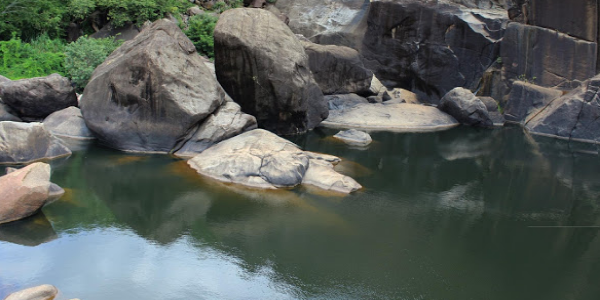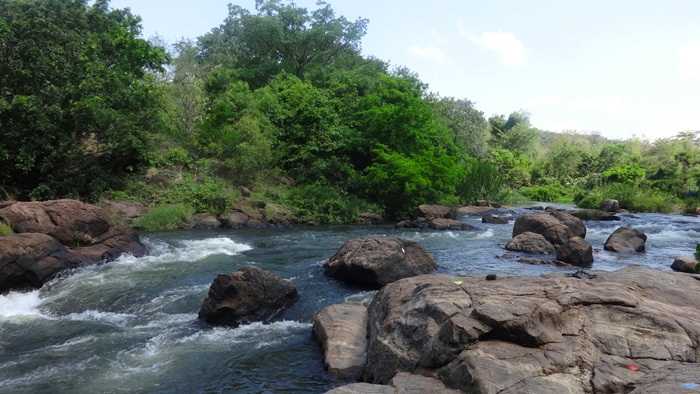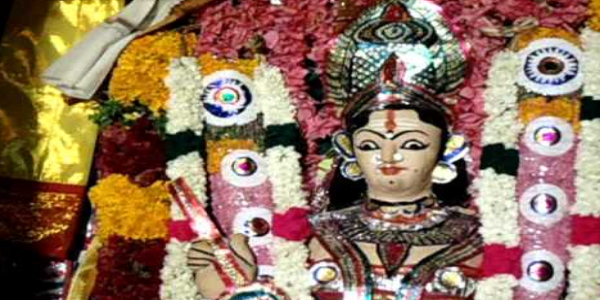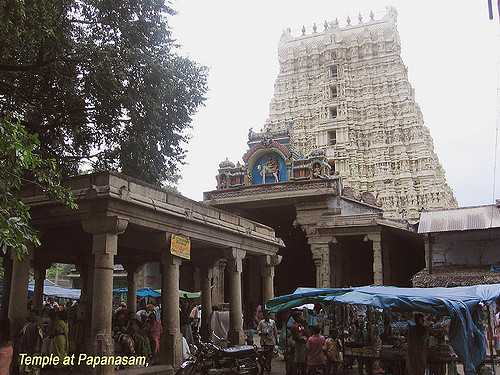The first Kailasam Temple built by Uromasa Maharishi (உரோமச மகிரிஷி) is at Papanasam. Lord Shiva takes the form of the Sun God here. The Lord “Shri Papanasar”( ஶ்ரீ பாபநாசர்) is also known as Kailasa Nathar, Pazhama Nayagan, Mukkaleenga Nathar, Vayirasalinangam. The Goddess is “Ulagammai” (உலகம்மை).
It is believed that worshipping the Lord at this temple is equal to worshipping the Lord at the “Suriyanar Temple” (சூரியனார் கோவில்) near Kumbakonam. This temple is considered special for people of the Sun Sign, Leo (சிம்ம ராசி).
Legends about the Temple
There are several folklores that narrate the legends and wonders of this temple.
Origin of the Three Dynasties of Tamil Nadu
-
- Spiritual Guidance Offered by Narathar
Long ago, the magnificent Podhigai Hills, Saiya Hills and Tharuthira Hills of the Western Ghats were looking sad. The great sage Narathar enquired the reason for their sadness. The hills replied that, in spite of being majestic they were never praised by any mortal. So they asked the sage to help them. Naradhar guided them to worship Lord Shiva and he sprinkled the water from his holy jug on them. The hills were enlightened and learnt the ways to worship Lord Shiva from the sage. He also taught them a five letter panchakshari mantra “namasivaya” that guides one in both, life as well as death. - Lord Ganesha’s Forewarning
The three hills prayed to Lord Ganesha on Vinagayar Chathurthi, which occurred on a Friday in the Tamil Month Aavani. They beseeched a snow covered Lord Ganesha, to help them attain the divine blessings of Shakthi. The Lord replied that the bad Karma of the three hills would take the form of an elephant and come to destroy them on the day before Navaratri. If they prayed to the divine Goddess Shakthi when they are under attack, they will be blessed with her strength.
- Spiritual Guidance Offered by Narathar

- Goddess Shakthi’s Destruction of the Karmic Elephant
Just like Lord Ganesha had warned, their karma approached them in the form of a huge elephant. The three hills prayed to Goddess Shakthi and requested for her help. The Goddess came to the rescue of her devotees and transformed her vahana, the lion, into an arrow to attack the elephant. The Goddess aimed the arrow at the elephant and hit him, saving the mighty hills from destruction. The place from where the Goddess shot the arrow is known as “Singa Theertham” (சிங்க தீர்த்தம்) or “Kalyana Theertham”( கல்யாண தீர்த்தம்). The place, where the arrow struck the elephant is known as “Banatheertham”( பாண தீரத்தம்) - Wishes of the Hills Come True
The relieved hills asked the Goddess to help them attain human birth. Shakthi guided them to perform penance for Lord Shiva and on Maasi Shivaratri (Shivaratri that occurs in the Tamil month of Maasi), Lord Mukkalingar will turn them into Chozha, Chera and Pandya Kings. The hills finally were granted their wish and went on to become the founders of the three famous dynasties of ancient Tamil Nadu. A shrine of Lord Shiva in the form of “Mukalinga Nathar” (முக்காலிங்க நாதர்) is found at the foothills.
Penance of Viartu Purushan
According to Hindu Mythology, “Viratu Purushan”( விரட்டு புருஷன்) the man who holds up the Earth, wished to be relieved of his burden. So he was involved in a penance for several years at Papanasam. Lord Shiva appeared before him on Maasi Shivaratri and said, “You have several crores of years before you can be rid of your karma”. Viratu Purushan then requested the Lord to bless all the people who visit the first Kailasam. The Lord then promised him that all those who pray at this temple on Maasi Shivartri, will be rid of their karma and can attain salvation. The Lord of this temple is also known as “Vayirasa Lingam” (வயிராச லிங்கம்) after Viratu.
Vedas Surrounding the Lingam
The four ancient Vedas Rig, Yajur, Sama and Adharvana came to this holy place and worshipped Lord Shiva. The Atharvana Veda took the form of the sky and the other Vedas took the form of “Kalaa Trees” (களா மரம்). They offered their sacrifices for the Lingam by showering flowers, nectar and fruits. Since the three Kala Trees surround the Lingam, the shrine is also known as “Mukkalingar” (முக்காலிங்கர்).
Sage Agasthya’s Vision of the Divine Marriage
As all the Gods conglomerated to witness the marriage of Lord Shiva and Parvati, the Earth lost its balance and was tilted. To restore the equilibrium, the Lord commanded Sage Agasthya to travel South. The Sage asked,” Lord, How can I witness your divine wedding?”. The Lord promised, “I will bless you with a vision of the Holy marriage, right where you are”. He also gave the river Thamirabarani, another form of the mighty Ganges to the Sage. Agasthyar set forth on his journey, with the River in his holy pitcher. The powers of the copper bead worn by the Goddess, permeated the waters of the river as she took a dip. Hence the river Thamirabarani got its name.
The mighty River Cauvery originated, when Lord Ganesha in the form of a crow, dashed against the pitcher at Kudagu malai (குடகுமலை). The Earth was restored as soon as he reached Podhigai Hills. Sage Agasthiyar watched the divine marriage at a place called “Kalyana Theertham” near the source of the River Thamirabarani, on the first day of the Tamil Month Chithirai. Hence the “Visu Festival” (விசு திருவிழா) is celebrated grandly on this day at Papanasam.
Papanasam – The Place where one is freed from one’s Sins
- Redemption of the Siblings from their Sins
Long ago, a King named “Chithiraisenan” (சித்திரைசேனன்) ruled parts of North India. Due to his karma, he built wrong friendships and began to inflict sufferings on his countrymen. The people, who did not wish to live under a tyrant, began to move to the forest. A merchant, Vitunukundan, decided to leave the country with his wife and children. On the way, the merchant and his wife passed away and the children got separated. Several years later, the brother and sister met each other. Without realising they were siblings, they fell in love and got married. Later when they realised their folly they repented and sought the help of learned men. They instructed them to wear black clothes and to take a dip in several sacred bathing Ghats. At the holy waters where their black clothes turn white, they would be freed of their sins. They took many dips in several sacred ghats in and around Kasi, but failed to be liberated. Finally when they bathed in Papanasam, their clothes turned white and their sins were forgiven. - Emancipation of Sundaran from “Brahmahathi Dosham”
Sundaran, a learned Brahmin, belonged to the Gavuda Kingdom of the North. He was suffering from Bhramahathi Dosham (பிரம்மகத்தி தோஷம்) as he had treated his parents cruelly and killed them. He went to several places and prayed to be freed from his sins. Finally, when he took a dip in the waters of Thamirabarani at Papanasam, the karma of his sins were uplifted.
Lord Indra, Sage Agasthiyar, Viratu, The three Hills of Podhigai Ranges, Sundara Pandian, Karunagara Pandian, Indrathooiman also known as Raja Raja Pandian, Sundaran, Arikundan are some of the people who were freed from their sins and attained divine blessings at Papanasam.
Divine Wonders Performed by Ulagammai
It is also believed that the Goddess Ulagamai (உலகம்மை) of this temple grants the wishes of all her devotees. A famous poet, Namashivaya Kavirayar (நமச்சிவாய கவிராயர்) was well known for his songs praising the Goddess. Spell bound by the melodious lyrics of the poet, Ulagamai Herself used to go in search of the poet and listen to him. The poet had a habit of chewing betel leaves and once his spit fell on the saree of the Goddess. The guards noticed this stain on the idol of the Goddess at the temple. They then went in search of the poet and took him to the King.
The King decided to test the innocence of the poet and hung a flower with a golden string. He then asked the poet to compose lyrics for the Goddess and make Her gift the flower to him. The poet sang the Ulagammai Anthathi (உலகம்மை அந்தாதி). When he reached the 96th verse, the flower broke the golden string and dropped into his hands. This proved the blessings of the Goddess for her devotee and the suspicions on him were lifted.
As the poet grew old, he developed wounds on his whole body and suffered from unbearable pain. So, he tried to end his life by trying to drown in the waters of Kalyana Theertham. However the Goddess stopped him and said, “The karma of your previous births is still following you. If you commit suicide, you will have to bear your karma even in the next birth. So withstand your suffering and you will be freed from the cycle of life”. . As days passed, the poet lost his wife and was living with his daughter. Once while she had gone out, the Goddess came in the form of the daughter and served food for the poet. These are some of the few incidents that stand as a testimony to the wonders done by the Goddess.
Architecture of the Temple
As soon as we come near to the temple, the first sight that treats us is the magnificent view of the 80 feet temple tower with seven levels. The architectural structure depicts the Sun God. The South flowing Thamirabarani changes its course to the East in front of this temple. As there are no steps to the bathing Ghat, several fences have been installed to prevent devotees getting caught in the strong under-current of the river.
Shrines of the Deities
There are two sanctums in the temple one for Papanasa Nathar and the other for Ulagammai. There are three courtyards before the inner sanctum: Mada Veethi, Nandavana Sutru and the Ul-Sutru(Inner Courtyard). The flag mast, Nandi statue, the sacrificial altar and the shrines of Bootha Vinayagar and Lord Subramanian are present in the inner courtyard. The statue of Lord Natrajar faces the South so as to enjoy the breeze from the Podhigai Hills. The shrines of the 63 Nayanmars, Veera Puthirar, Abirami, Maheswari, Gowmari, Narayani Vargi, Indrani and Kali are also present here. The shrine of Dakshinamoorthy faces South and Kalyana Sundrar is seen in his wedding finery. As mentioned in Hindu mythology, the shrine of Mukkalingar is surrounded by three Kala Trees.
Sacred Bathing Ghats
There are several bathing ghats such as Thamirabarani Theertham, Vedha Theertham, the old Papanasa Theertham, Kalyana Theertham, Pana Theertham and Vairava Theertham. The Agasthiyar falls at Papanasa Theertham is ideal for kids to bathe. This waterfall is never dry as it is fed by the life waters of Thamirabarani, throughout the year. The Banatheertham at a distance of 14kms from here is the place where Lord Ram performed the funeral rites for his father King Dasarathar on Aadi Amavasai (The New Moon day that occurs in the Tamil Month of Aadi, mid-July to mid-August). Hence on this day hordes of devotees gather to perform the rites for their ancestors. The temple tank festival is celebrated on Chithirai Visu (சித்திரை விசு) at the Lotus shaped temple tank.
Mukalinga Rishi, in his literary work on Papanasam, mentions that even the Ganges, the holiest of all Rivers, flows to Papanasam in the month of Marghazhi (mid-December to mid-November) to be freed from its sins. According to Hinduism, a person can be freed from his sins by taking a dip in the holy water of the Ganges at Kasi. The unique quality of Papanasam is that the waters here can even destroy the sins one acquired in Kasi.
It is believed that eye and skin diseases are cured when one prays at this temple.
How to Reach Here
You can reach this temple by buses that run to Papanasam from the Tirunelveli New Bus stand. The nearest railway station is at Ambasamudhiram at a distance of 5kms from Papanasam.
Temple Timings
Morning: 6.30 a.m. to 12.00 p.m.
Evening: 5.00 p.m. to 8.00 p.m.

